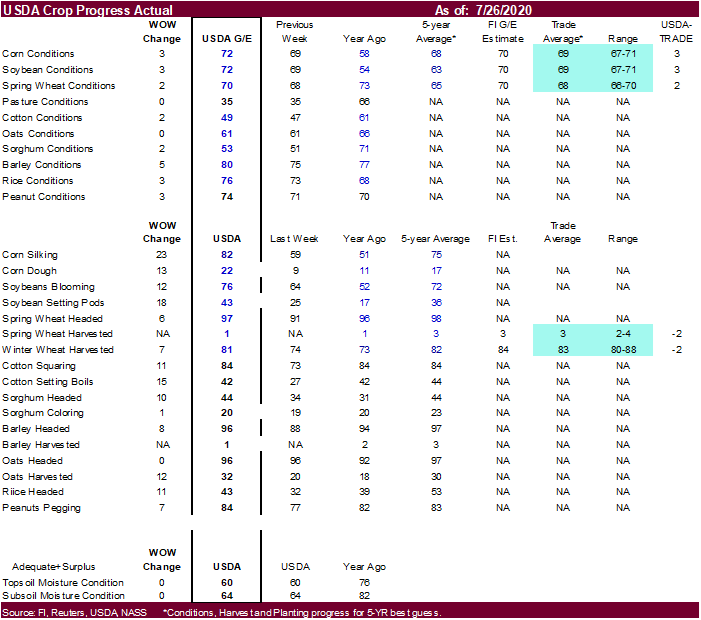PDF Attached
CALLS:
Soybeans down 5, Corn down 2-3, and wheat down 4-5.
Egypt
is in for wheat. USDA announced 250,371 tons of soybeans to Mexico and 132,000 tons of soybeans to China. USD was down 74 this afternoon and gold up a strong amount. US weather looks very good over the next 10 days with no excessive high-pressure ridge and
no prolonged periods of hot temperatures.
Euro
– Monthly
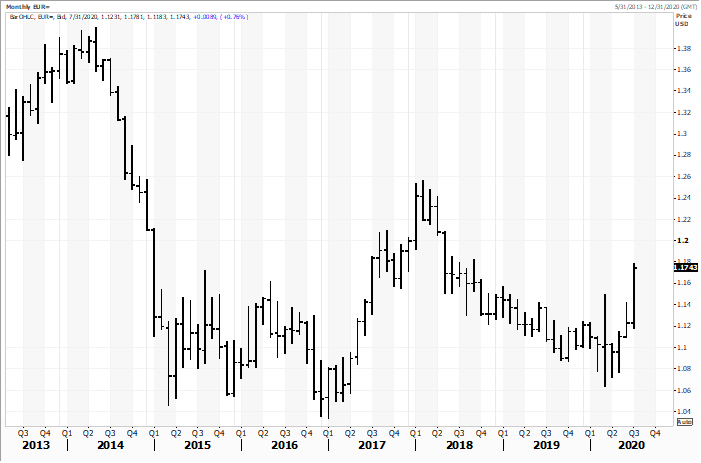

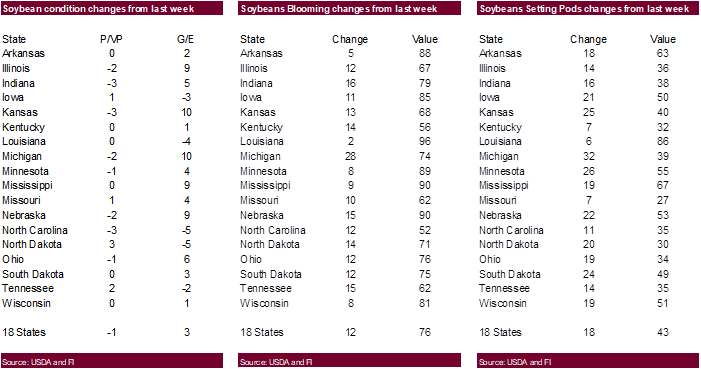
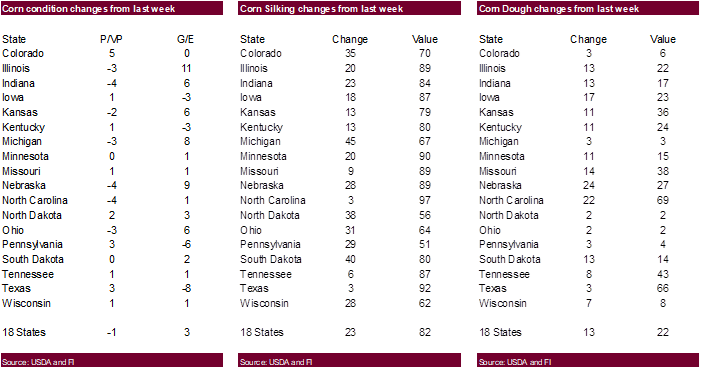

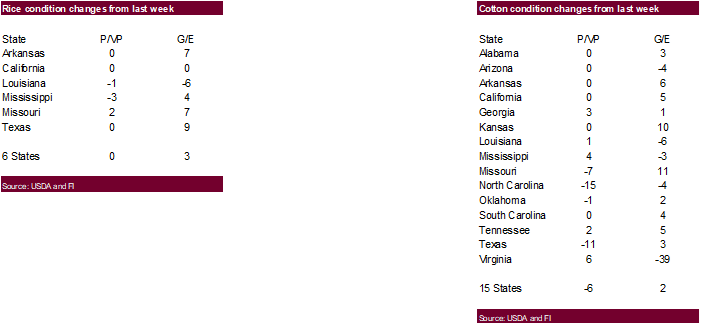
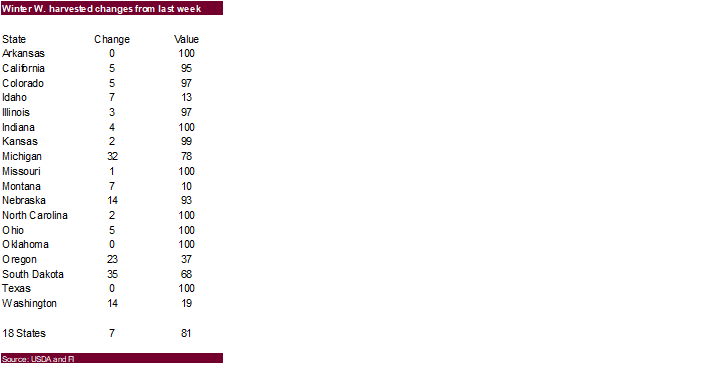


7
Day Precipitation Outlook
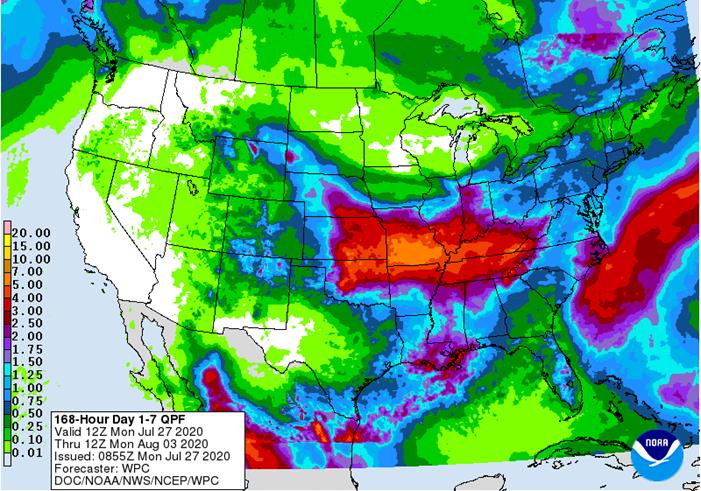
-
Hurricane
Douglas was a major hurricane this morning located 1010 miles east southeast of Hilo, Hawaii moving west northwesterly at 18 mph and producing maximum sustained wind speeds of 130 mph -
Hurricane
force wind is occurring out 30 miles from the storm center while tropical storm force wind was occurring out 90 miles -
Douglas
will continue to move toward the Hawaiian Islands and will impact the region this weekend with some damaging wind, heavy rain and flooding -
The
storm’s current path takes the system north of the Big Island of Hawaii Saturday night into Sunday as a weakening hurricane -
The
storm will move very near to or directly across Maui and have impacts on Lanai and Molokai as well as some of the smaller islands nearby as a tropical storm -
The
storm’s small size will help limit the extent of damage, but there is a strong potential that the storm will move across some of the central Islands causing some damage
-
Kauai
and some of the neighboring islands will not be seriously impacted by the storm, although some high wind speeds and heavy rain is expected
-
Tropical
Storm Gonzalo may become a hurricane before reaching the southern Windward islands Saturday -
At
0800 EDT, the storm was 580 miles east of the southern Windward Islands moving westerly at 15 mph and producing maximum sustained wind speeds of 60 mph -
The
storm will pass through the southern Windward Islands Saturday and move into the eastern Caribbean Sea where it will remain through Monday morning – the storm may weaken or possibly dissipate as it moves toward Central America
-
Tropical
Storm Hanna was located 285 miles east of Corpus Christi, Texas at 27.1 north, 92.8 west moving west northwesterly at 9 mph and producing maximum sustained wind speeds of 40 mph -
Hanna
will likely move inland near Corpus Christi, Texas Saturday -
The
storm will bring heavy rain to portions of southern Texas and could raise some crop quality issues to open boll cotton in southern Texas
-
Flooding
is expected along the lower Texas coast where 3.00 to 8.00 inches and local totals over 10.00 inches will be possible -
The
storm will ultimately end up in northeastern Mexico early next week
-
Southwestern
and some central Canada Prairies crop areas will experience a steady drying trend and warm temperatures over the next week to ten days
-
Crop
moisture stress will be on the rise -
Late
season canola and flax might be impacted with lower yields -
Early
season crops will likely be far enough advanced to no be seriously impacted; this includes spring cereals
-
China’s
weather is expected to improve during the next two weeks with no more widespread excessive rain events expected -
Some
localized areas of heavy rain will be possible with local flooding, but most of the nation’s damaging weather is over and an assessment of the losses will be made as flood water recedes
-
Recent
flooding in China has damaged many crops, but assessing the losses has not yet been done because flooding is still under way in many areas
-
Northern
China crops are in mostly good condition, although some flooding recently occurred in Henan and Shandong that might have induced some damage in low-lying areas
-
Xinjiang,
China continues cooler than usual and degree day accumulations are falling below average -
Weather
conditions will remain unsettled and a little cooler biased for a while -
Showers
will stay near the mountains -
Northeastern
Xinjiang cotton areas will see daily highs in the upper 70s and 80s for a while and lows in the 50s and 60s -
Other
cotton areas in the province will see daily highs in the middle 80s through the middle 90s with lows in the 60s -
Warming
is needed, but not likely for the next ten days
-
India’s
monsoon continues to perform mostly very well, but recent rain has become lighter than usual -
Rainfall
in the central and north has been a little light recently and greater rain is needed especially in Rajasthan -
August
will be a better month for rainfall in the far northwest -
Total
rainfall this summer is expected to be slightly greater than usual, but some of that is predicated upon developing La Nina conditions in late August and September -
Rain
has been well enough distributed in recent weeks to support very good crop conditions in most of the nation
-
Southern
Pakistan has not had much rain so far this summer, but improved rainfall is expected next month
-
Mainland
areas of Southeast Asia have been getting enough rain to support crops, but the monsoon has been lackluster recently and greater rain is needed to begin improving long term soil moisture and water supply -
Portions
of western Thailand and Vietnam have been reporting the lightest rainfall relative to normal and a boost in rain is needed
-
The
erratic rainfall is expected to continue for a little while longer, but August should bring greater precipitation
-
Philippines,
Indonesia and Malaysia rainfall has also been a little erratic recently, but like the mainland areas of Southeast Asia crop conditions are mostly rated well with little immediate change likely -
Eastern
Australia will receive rain today and Saturday in New South Wales and southeastern Queensland to improve topsoil moisture and support establishing winter crops -
Lingering
showers are expected into early next week -
Other
areas in Australia will see little rain over the next ten days except near the coasts, but winter crops have stablished relatively well this year -
Rain
is still needed in South Australia and more will be needed in Queensland, but the outlook leading into spring is still looking much better than that of the past couple of years
-
Argentina
has received some welcome rain in parts of Buenos Aires and La Pampa over the past two days improving wheat conditions -
Cordoba
is unlikely to get much rain of significance and it produces 20-23% of the total wheat crop -
Cordoba
has been quite dry since the planting season began and a cut in production has already occurred and more will be possible if dryness prevails much longer -
Other
crop areas in Argentina have had timely rainfall to support wheat and barley, although this week’s rain was a little disappointing in parts of Santa Fe which has also been experiencing some dryness -
Drier
weather will be returning to Argentina this weekend and it may last ten days leaving the dry areas without much hope for change
-
Southern
Brazil’s soil conditions and weather will continue plenty moist for a while -
Winter
crop conditions are mostly good in Rio Grande do Sul and areas north into Parana, but Sao Paulo and a few other areas have been quite dry recently -
Summer
crop harvest progress has been good -
Conditions
for early season corn planting are looking favorable, but timely rain will need to continue in August to ensure early crops are successful
-
Harvest
weather in center west and center south Brazil for Safrinha crops has been and will continue to be good
-
U.S.
weather is expected to remain favorable over the next ten days, despite an erratic distribution of rain -
No
extreme heat is expected -
Showers
will continue periodically -
The
second week of the outlook will trend a little drier, but the models are likely to fall back into a classic mid-summer weather pattern of periodic showers and thunderstorms and warm temperatures in weeks 2 and 3 -
This
pattern usually leads to net drying which is not unusual for August -
Pockets
of dryness will evolve and some new crop stress will be possible, but much of this is going to occur in August and not in this next ten days – no widespread serious moisture shortage is expected through the second week of August -
Corn
pollination and early season soybean blooming will continue to advance well in this environment
-
West
Texas received some scattered showers and thunderstorms this week with a few more expected today and possibly into the weekend before drier weather evolves for a little while -
Some
additional shower activity is possible late next week and into the following weekend, but it may be less significant than that of this week -
Most
of the daily rainfall expected through the weekend and that which occurs late next week will be erratic and not great enough to seriously change soil moisture, but it will help put a little moisture in the air and supplement some irrigation -
Many
areas will still be dry -
No
extreme heat is expected for at least the next ten days -
Daily
highs in the 90s will occur often with a few readings near 100 during the weekend and through mid-week next week
-
U.S.
Delta is one of the drier areas in the U.S. crop region with central parts of the region driest -
Showers
will occur periodically over the next couple of weeks resulting in some relief in the driest areas, but more rain may still be needed
-
U.S.
southeastern states are seeing enough rain to maintain mostly good crop conditions, but very warm temperatures are accelerating drying rates between rain events -
Daily
highs in the 90s will prevail for the next week temperatures will be warmest next week
-
Far
northwestern U.S. Plains will struggle for big soakings of rain over the next couple of weeks and net drying is expected -
Temperatures
will also be quite warm at times
-
U.S.
Pacific Northwest rainfall will be minimal over the next two weeks
-
California
and the Great Basin will be dry and warm for a while
-
Drying
will continue from portions of central and eastern Ukraine through a part of Russia’s Southern Region to Kazakhstan -
Dryness
has been eased recently in northeastern Ukraine and a little more rain may fall next week after a period of drying
-
France
remains too dry and parts of the United Kingdom, Belgium, Netherlands and northwestern Germany also need rain -
These
areas will not get much moisture, but there will be a few showers coming up briefly this weekend and next week
-
Germany,
the U.K., Belgium and Netherlands may get enough rain for temporary crop improvements in a few areas next week
-
Portions
of the southernmost Balkan Countries in southeastern Europe need greater rain to improve dryland crops
-
Scattered
showers will occur during the coming week to ten days -
No
rain is expected in the southern Balkans or from eastern Ukraine into western Kazakhstan
-
Ontario
and Quebec, Canada have some pockets of dryness, but most crops in the two provinces are still developing relatively well -
Any
missed rain could lead to greater crop stress and a close watch on the situation is warranted
-
South
Africa weather over the next couple of weeks will include limited rainfall and temperatures will trend a little warmer over time.
-
West-central
Africa will receive periods of rain over the next couple of weeks maintaining a favorable environment for coffee, cocoa, cotton, rice and sugarcane -
Greater
rain is needed in Ivory Coast and Ghana where rainfall so far this month has been notably lighter than usual
-
Russia’s
New Lands will receive some cooler temperatures and scattered showers during the coming week to ten days resulting in better soil and crop conditions after recent dry and warm weather -
Not
all areas will get adequate relief and will need additional rain -
About
30% of the spring wheat and sunseed areas will get relief -
All
other areas will need significant rain
-
Northeastern
Mexico will continue very dry and warm to hot over the next two weeks -
Scattered
showers and thunderstorms are likely elsewhere with rainfall mostly near to above average
-
Improving
soil moisture in many areas will lead to better crop development potential
-
Central
America rainfall will be well mixed over the next ten days with rain falling in most areas, although amounts may be a little lighter than usual in Honduras
-
New
Zealand rainfall over the next couple of weeks will be erratic and most often light with temperatures being near to below average
-
Southern
Oscillation Index was +4.18 this morning and the index will rise additionally this week
- USDA
weekly corn, soybean, wheat export inspections, 11am - U.S.
crop conditions for soybeans, corn, cotton; winter wheat progress, 4pm - MARS
crop bulletin – monthly report on crop conditions in Europe - International
Sugar Organization webinar on China’s market - EU
weekly grain, oilseed import and export data - Indonesia
palm oil export tax for August to be announced sometime during the week - Ivory
Coast cocoa arrivals - HOLIDAY:
Thailand
TUESDAY,
July 28:
- EARNINGS:
Minerva - HOLIDAY:
Thailand
WEDNESDAY,
July 29:
- EIA
U.S. weekly ethanol inventories, production, 10:30am - Vietnam’s
General Statistics Office releases data on exports of coffee, rice and rubber
THURSDAY,
July 30:
- USDA
weekly crop net-export sales for corn, soybeans, wheat, cotton, pork, beef, 8:30am - Port
of Rouen data on French grain exports - The
Australian Grains Industry Conference (online event) - Poland
to publish grain harvest estimates
FRIDAY,
July 31:
- ICE
Futures Europe weekly commitments of traders report, 1:30pm (6:30pm London) - CFTC
commitments of traders weekly report on positions for various U.S. futures and options, 3:30pm - FranceAgriMer
weekly update on crop conditions - Malaysia’s
palm oil export data for July 1-31 (tentative) - U.S.
agricultural prices paid, received, 3pm - HOLIDAY:
Singapore, Indonesia, Malaysia
Source:
Bloomberg and FI
USDA
inspections versus Reuters trade range
Wheat
544,010 versus 450000-700000 range
Corn
797,487 versus 900000-1200000 range
Soybeans
472,680 versus 350000-700000 range

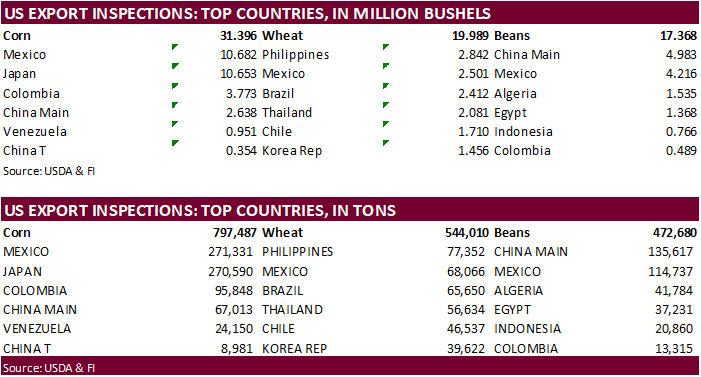
GRAINS
INSPECTED AND/OR WEIGHED FOR EXPORT
REPORTED IN WEEK ENDING JUL 23, 2020
— METRIC TONS —
————————————————————————-
CURRENT PREVIOUS
———–
WEEK ENDING ———- MARKET YEAR MARKET YEAR
GRAIN 07/23/2020 07/16/2020 07/25/2019 TO DATE TO DATE
BARLEY
0 49 931 416 2,938
CORN
797,487 1,175,910 670,962 37,172,067 44,281,166
FLAXSEED
0 0 24 317 48
MIXED
0 0 0 0 0
OATS
0 100 0 500 299
RYE
0 0 0 0 0
SORGHUM
83,988 124,654 9,126 4,348,077 1,840,728
SOYBEANS
472,680 454,719 1,066,123 38,789,707 40,348,754
SUNFLOWER
0 0 0 0 0
WHEAT
544,010 512,305 421,468 4,130,890 3,829,816
Total
1,898,165 2,267,737 2,168,634 84,441,974 90,303,749
————————————————————————-
CROP
MARKETING YEARS BEGIN JUNE 1 FOR WHEAT, RYE, OATS, BARLEY AND
FLAXSEED;
SEPTEMBER 1 FOR CORN, SORGHUM, SOYBEANS AND SUNFLOWER SEEDS.
INCLUDES
WATERWAY SHIPMENTS TO CANADA.
US
Durable Goods Orders Jun P: 7.3% (est 7.0%; prevR 15.1%; prev 15.7%)
US
Durable Goods Ex-Transportation Jun P: 3.3% (est 3.5%; prevR 3.6%; prev 3.7%)
US
Cap Goods Orders Nondef Ex-Air Jun P: 3.3% (est 2.4%; prev 1.6%)
US
Cap Goods Ship Nondef Ex-Air Jun P: 3.4% (est 2.8%; prev 1.5%)
-
Corn
futures ended unchanged
to 1.25 cents lower on lack of direction. Soybeans were higher while wheat was under pressure. Lower USD limited losses.
Weekend rains were very good for
the northern US Great Plains. Funds sold an estimated net 5,000 corn. -
US
corn and soybean ratings this afternoon were up by 3 each and should set a bearish undertone tonight. Note IA, where dryness occurred, corn was 77 G/E.
·
US CORN – 72 PCT CONDITION GOOD/EXCELLENT VS 69 PCT WK AGO (58 PCT YR AGO) -USDA
·
US CORN – 82 PCT SILKING VS 59 PCT WK AGO (75 PCT 5-YR AVG) -USDA
·
US CORN – 22 PCT DOUGH VS 9 PCT WK AGO (17 PCT 5-YR AVG) -USDA

-
China
corn futures (one point up 4.3% overnight) reached a 5-year high on tight supplies even after record reserves auction volumes. Corn futures settled near 2340 CNY, equating to about $8.50 per bushel or $335 / ton. China has been battling drought conditions
across the northeast and pig numbers are on the rise. Meanwhile bad flooding occurred over the weekend again across the upper reaches of the Yangtze River.
-
Note
China corn production could fall from last year. USDA currently projects 2020 China corn production at 260 million tons, down from 260.77 million tons for 2019-20. China’s AgMin sees a 266MMT crop with demand at 285 million tons. It’s in our opinion China’s
government will grant additional TRQ’s corn imports to meet rising feed demand, and today we saw conformation they did by adding another 2 million tons to a total of 9.2 million tons. It’s either that or China might be forced to import more than 100 million
tons of soybeans. -
We
didn’t see any major global tender business over the weekend. -
In
a Reuters survey, traders see South Africa’s corn crop (2019-20) at 15.461 million tons, 9.081 white and 6.443 million yellow. 15.461 million tons is 37 percent more than 2019. More than 50 percent of the corn crop has been harvested and delivered to silos.
-
USDA
last week reported US calve slaughter down 33 percent from a year ago and calf/veal production off 21 percent. Hogs slaughter was up 10 percent from the previous year and pork production up 12 percent.
Corn
Export Developments
-
Syria
seeks 50,000 tons of soybean meal and 50,000 tons of corn on Aug 25 for delivery within four months of contract signing.
China
corn futures – monthly, second month rolling contract
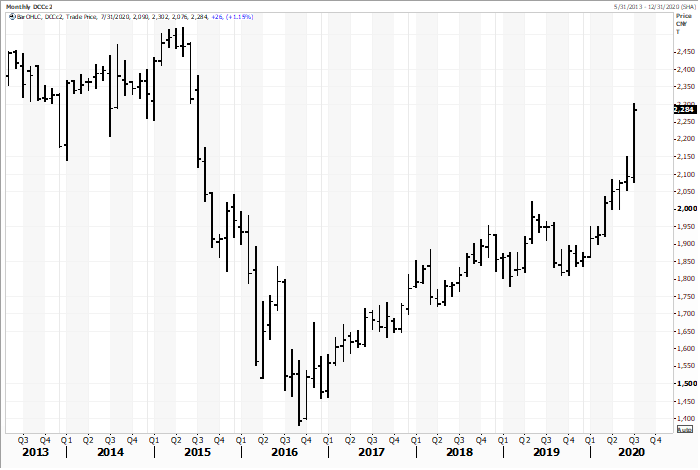
Source:
Reuters and FI
- September
corn is seen in a $3.10 and $3.35 range over the short term. December lows could reach $3.10. We can’t justify below $3.00 unless a shock in the September grain stocks report occurs, or China’s production gets upward revised by a large amount.

